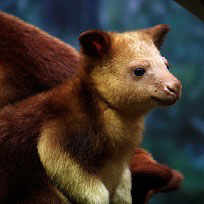
Studying for the LSAT takes up an incredible amount of time. You literally spend hundreds of hours learning about dinosaurs, sea turtles, and cryptozoological marsupials. And you can’t help but remembering some of the more interesting nuggets you learn along the way. Knowing that you’re gaining a wealth of useless trivia is one of the things that makes studying for the LSAT slightly more bearable. Sadly, you can’t always trust logical reasoning as a source of unbiased (i.e., non-made-up) factoids. But often the subject matter is true, as well. Starting today, I’m going to look at some of the more interesting bits of real information that the LSAT has given us over the years.
October 1998 – Tree kangaroos lose their thumbs but gain a heart.
Over a decade ago, the LSAT tried to tell us all about “tree kangaroos.” When I first saw this I thought that the test writers were clearly dabbling some Dr. Moreau territory. As it turns out, though, tree kangaroos are totally real, and insanely adorable. They look like stuffed animals that would make an 8-year-old girl squeal with delight, forgetting about ponies forever. I mean, seriously, look at this picture.
That was the sound of the cuteness receptors in your brain exploding. They’re kangaroos. That live in trees. And they love you.
Tree kangaroos are also unbelievably good jumpers, being able to fall from 60-foot trees unscathed. And their stomachs are fermentation vats. I’m not sure what that means, but it makes me like them even more. In Australia, a place full of the most terrifying animals on earth (see: funnel-web spiders, Irukandji jellyfish, Australians), the tree kangaroo is probably revered as a god.
But what about when the LSAT said…
The subject of this LSAT question had to do with the fact that tree kangaroos don’t have opposable thumbs and grasping tails, which would be pretty sweet things to have in your possession if you lived in a tree. This is especially strange, considering that ancient-kangaroos did have these things. Where’d they go? Well, as we learn in the correct answer choice, the tree kangaroos evolved from land kangaroos that had already lost these traits, as they weren’t so useful on land.
This, too, is true. Sucks for the tree kangaroos, no? Maybe, but it’s pretty awesome news for us. Because ancient kangaroos were the things that nightmares are made of. Back in 1997 scientists found the “kangaroo Rosetta stone” (really), a super old kangaroo from which all other kangaroos would follow. Sure, it had some nice opposable thumbs and galloped rather than hopped, but it also had fangs and a taste for blood. Here’s what the little rascal looked like:
According to a real scientist, these saber-tooth kangaroos “used to leap out from behind trees and scare the bejesus out of prey and then calmly chomp it to pieces.”
What did we learn? Well, for one, the LSAT writers appear to keep up on science journals – this question came out just a year after finding the skeleton. For some reason, I don’t find this at all surprising. Also, kangaroos used to be ruthless killing machines, but traded in their thumbs for souls. Lastly, the LSAT has once again shown us what a horrible, horrible place Australia is.






